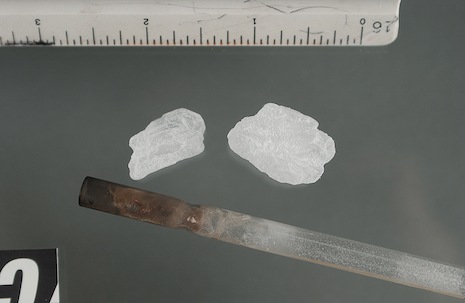Over forty years ago I’d made the entry in my notebook. I found my handwriting to be a bit difficult to read on some of the yellowing pages—the result of quickly-written memos then, and failing eyesight today. But I was able to make out the basics, and there was enough there to take me back to the time when I wore the brown over khaki uniform of a deputy sheriff.
Flipping through the pages of my log, one particular entry caught my eye. It was a Friday night during an unusually cool for October. According to my notes, the skies were clear and brightly lit by a near full moon. The gas tank in my take-home car was full (as always, I’d filled it at the end of my shift the preceding morning) and the speedometer had just tripped 80,000 miles. The lights and siren were both in working order.
I’d signed on at 2342 hours that night, and in my mind I can still hear the dispatcher’s voice as she acknowledged my radio message. She spoke in a drawl that prompted a craving for mint juleps and an urge to plant a magnolia tree in my front yard.
It’s no secret that I was not born a southerner. In fact, before “the conversion,” I was such a Yankee that one of my relatives owned a house that was once used by Harriett Tubman as a stop on her vast Underground Railroad network. We lived nearby, where people didn’t say things like, “Y’all” or “finer’n frog hair, or “fixin’ to” (going to).
“I’m fixin’ to head over to the Piggly Wiggly to pick up some chittlins’ for Sunday lunch. Y’all want anything?”
As a child born north of “the line”, the switch to the South was a major change. Everything was different, including schools and how they conducted business. Classes in our new southern location began each day with a child reading from the Bible, followed by a man’s deep but southern-twangy voice spewing from the wall-mounted speaker as he led us in prayer. We didn’t do that in my former northern school.
The thing about the South that stuck with me the most, though, was to see peanuts, tobacco, and cotton in their natural habitats—not nuts in jars or bags, tobacco rolled into cigarettes, or “cotton” as a word printed on the labels of my school clothes.
Okay, back to my notes. It hadn’t rained in nearly three weeks and the local farmers and their field hands had been hard at work for several days, picking cotton. They’d loaded large farm trailers to the point of overflowing, like giant pillows on wheels. But no matter how hard they tried, there was simply no way possible to gather every single piece of cotton, leaving lots of it scattered about in the fields. And, of course, it didn’t take long at all for the wind to blow the scraps of freshly picked raw cotton everywhere, sending it into trees, ditches, bushes, and roadways. The landscape looked as if it had been dusted by a light snowfall. You couldn’t spit in any direction without hitting a wad of the future shirts, pants, sheets, and stuffing for aspirin bottles.
Virginia cotton
At night, while on patrol, we often used our spotlights to scan fields and paths looking for illegal night hunters, or stolen cars and farm equipment that were sometimes abandoned in out of the way locations. Another target for our spotlights in those days were farmer’s fertilizer storage tanks that contained anhydrous ammonia. Farmers used the fertilizer to spray crops. Makers of methamphetamine stole it from farmers and farm supply companies to produce meth.
Meth makers siphoned the deadly liquid gas from the tanks and later used it and other hazardous ingredients, such as paint thinner, engine starter fluid, the innards of certain types of batteries, and ephedrine separated from its binding agent found in over-the-counter cold medicine, to manufacture the dangerous and illegal drug. This process required no heat since the chemical reaction was so volatile, and it is the reason clandestine meth labs notoriously and suddenly explode.
The method of making meth using anhydrous ammonia is sometimes called the “Nazi cook,” named after the meth distributed to German soldiers by Nazi leaders during World War II. For more, click here.
So yeah, that was a thing back then and it was a big reason we kept on eye on farms. And, of course, there were the people who stole livestock, such as pigs. Ah, the glamorous life of a deputy sheriff in the rural South.
In addition to highlighting stolen cars and fertilizer tanks, and the occasional “parking” teenage couples or pair of adulterers, the shining of a bright spotlight across the fields at night, the car-mounted devices also illuminated scores of wildlife—deer, foxes, raccoons, ‘possums, coyotes, and even an occasional black bear. And, on the night referenced in my spiral notebook, the light also showcased a woman’s body lying between two unpicked rows of cotton.
She was young, mid to late 30’s. Fully clothed with the exception of her bare feet. There were no shoes at the scene. Approximately 5’ 5″ tall. 150 lbs – 160 lbs, or so. Round face. Skin the color of Vermont maple syrup. Her eyes were open and without focus, and aimed toward the sky into infinity. Pupils fixed, and dilated. A bullet wound to her forehead, just above her left eye, and another near her right eyebrow, told me to save my CPR skills for another day.
Small clumps of loose cotton dotted the area around the body. Some were the brilliant white of summertime clouds. Others, the ones that clung to her wounds, were rusty red and mostly saturated with the victim’s drying blood.
Three sets of footprints entered the field—large boots, small tennis shoes, and a set ending with bare toes. Only two sets headed out. The toes remained.
The victim had two small children at home. A neighbor was called to sit with them while their father went out searching for his wife who’d called earlier to say the church meeting was running a bit longer than she’d expected. No, no need to pick her up. Wanda was at the meeting and would bring her home.
Twenty minutes later, after the husband left his children in the care of the sitter, Wanda called and asked the neighbor if she could please speak to the man’s wife. No, there was no church meeting that night.
The man knew, deep in his heart, that there was no meeting at the church and he where exactly where to look for his cheating wife.
The victim’s lover, a cotton farmer, escaped the gunfire.
There was no DNA. No fingerprints. No cell phone calls to trace, and no bullet casings.
Just a pair of womens shoes found five hours later, in the farmer’s truck. And a revolver containing four bullets in his jealous wife’s car.
If I’d kept a tally over the years I could’ve added another hash mark to the “life taken” column, and five to the “lives ruined” section.
My last notations on the page that night were four short lines that read …
“Murder warrant issued”
“17 gallons of gas, no oil”
“10-42 (off duty) – 0815”
“Sunny and warmer – a good day to pick cotton”






